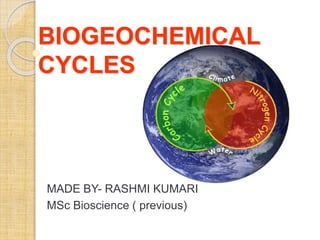
Biogeochemical cycles
- 1. BIOGEOCHEMICAL CYCLES MADE BY- RASHMI KUMARI MSc Bioscience ( previous)
- 2. What Sustains Life on Earth? Solar energy, the cycling of matter, and gravity sustain the earth’s life.
- 3. MATTER CYCLING IN ECOSYSTEMS Nutrient Cycles: Global Recycling Global Cycles recycle nutrients through the earth’s air, land, water, and living organisms. Nutrients are the elements and compounds that organisms need to live, grow, and reproduce. Biogeochemical cycles move these substances through air, water, soil, rock and living organisms.
- 4. ‘Fundamentals’ of biogeochemical cycles All matter cycles...it is neither created nor destroyed... As the Earth is essentially a closed system with respect to matter, we can say that all matter on Earth cycles . Biogeochemical cycles: the movement (or cycling) of matter through a system by matter we mean: elements (carbon, nitrogen, oxygen) or molecules (water)
- 5. TYPES OF BIOGEOCHEMICAL CYCLES ♦ Water cycle ♦ Oxygen cycle ♦ Carbon cycle ♦ Nitrogen cycle ♦ Phosphorous cycle ♦ Sulphur cycle.
- 6. HYDROLOGICAL CYCLE (WATER CYCLE) • Defined: Movement of water through the atmosphere • 75% of the earth is water • 99% of water undrinkable (salty & frozen) • Water recycles over and over Makes up 60-70% of your body
- 7. Water rises into the atmosphere in two ways: ◦ Evaporation: Heat changes water from a liquid to a gas ◦ Transpiration: Water evaporates from the leaves of plants through openings called stomata
- 8. Warm, moist air rises and eventually cools ◦ Condensation: process where water vapor turns into a liquid Rain, snow, sleet, or hail falls when water drops become heavy (Precipitation)
- 10. 1. Reservoir – oceans, air (as water vapor), groundwater, lakes and glaciers; evaporation, wind and precipitation (rain) move water from oceans to land 2. Assimilation – plants absorb water from the ground, animals drink water or eat other organisms which are composed mostly of water 3. Release – plants transpire, animals breathe and expel liquid wastes
- 11. OXYGEN CYCLE Autotrophs: Release O2 into atmosphere via photosynthesis All life: Absorbs O2 to be used during cellular respiration ◦ Respiration: creates ATP energy for cells
- 13. CARBON CYCLE • Carbon = (organic molecules) carbohydrates, proteins, lipids, nucleic acids • Plants & autotrophs: – Intake: Absorb CO2 from atmosphere Create glucose & sugar via photosynthesis – Output: Release CO2 during respiration Consumers ◦ Intake: Carbon moves up the food chain as 1 feeds on another ◦ Output: Release CO2 during respiration
- 14. • Decomposers –Input: Feed on dead organic matter –Output: Release CO2 during respiration –Output: Organic molecules returned to soil during decomposition Human Industry ◦ Output: Release CO2 into atmosphere when fossil fuels (coal, oil, natural gas) are burned
- 16. carbon is required for building organic compounds 1. Reservoir – atmosphere (as CO2), fossil fuels (oil, coal), durable organic materials (for example: cellulose). 2. Assimilation – plants use CO2 in photosynthesis; animals consume plants. 3. Release – plants and animals release CO2 through respiration and decomposition; CO2 is released as wood and fossil fuels are burned.
- 17. NITROGEN CYCLE: KEY POINTS Nitrogen is in the atmosphere as N2 (78%) N2 is an inert gas and cannot be used by plants or animals. N2 can be converted to a usable form via ◦ Lightening ◦ N-fixing plants and cyanobacteria ◦ Industrial process (energy intensive) Nitrogen limits plant growth. Nitrogen is easily lost from biological systems.
- 19. 1. Reservoir – atmosphere (as N2); soil (as ammonium, ammonia, nitrite, nitrate 2. Assimilation – plants absorb nitrogen as either NH4 + or as N03 -, animals obtain nitrogen by eating plants and other animals. 3. Release – Denitrifying bacteria convert N03 - back to N2; detrivorous bacteria convert organic compounds back to NH4 + ; animals excrete NH4 +, urea, or uric acid.
- 20. PHOSPHOROUS CYCLE Slide 41Slide 41Slide 41 GUANO FERTILIZER ROCKS LAND FOOD WEBS DISSOLVED IN OCEAN WATER MARINE FOOD WEBS MARINE SEDIMENTS weathering agriculture uptake by autotrophs death, decomposition sedimentation settling out weathering leaching, runoff DISSOLVED IN SOIL WATER, LAKES, RIVERS uptake by autotrophs death, decomposition miningmining excretionexcretion Figure 4-33 Page 82 uplifting over geologic time
- 21. Phosphorus is required for the manufacture of ATP and all nucleic acids 1. Reservoir – erosion transfers phosphorus to water and soil; sediments and rocks that accumulate on ocean floors return to the surface as a result of uplifting by geological processes 2. Assimilation – plants absorb inorganic PO4 3- (phosphate) from soils; animals obtain organic phosphorus when they eat plants and other animals 3. Release – plants and animals release phosphorus when they decompose; animals excrete phosphorus in their waste products
- 22. IMPORTANCE OF PHOSPHOROUS CYCLE 1.Phosphorous is an essential nutrient of both plants and animals. 2. It is part of DNA molecules which carry genetic information. 3. It is part of ATP and ADP that store chemical energy for use by organisms in cellular respiration. 4. Forms phospholipids in cell membranes of plants and animal cells. 5. Forms bones, teeth, and shells of animals as calcium phosphate compounds.
- 23. SULFUR CYCLE Slide 42Slide 42Slide 42 Figure 4-34 Page 83 Sulfur Hydrogen sulfide Sulfate salts Plants Acidic fog and precipitation Ammonium sulfate Animals Decaying matterMetallic sulfide deposits Ocean Dimethyl sulfide Sulfur dioxide Hydrogen sulfide Sulfur trioxide Sulfuric acid Water Ammonia Oxygen Volcano Industries
- 24. IMPORTANCE OF SULFUR CYCLE 1.Sulfur is a component of most proteins and some vitamins. 2.Sulfate ions (SO4 2- ) dissolved in water are common in plant tissue. They are part of sulfur-containing amino acids that are the building blocks for proteins. 3.Sulfur bonds give the three dimensional structure of amino acids. 4.Many animals, including humans, depend on plants for sulfur-containing amino acids.